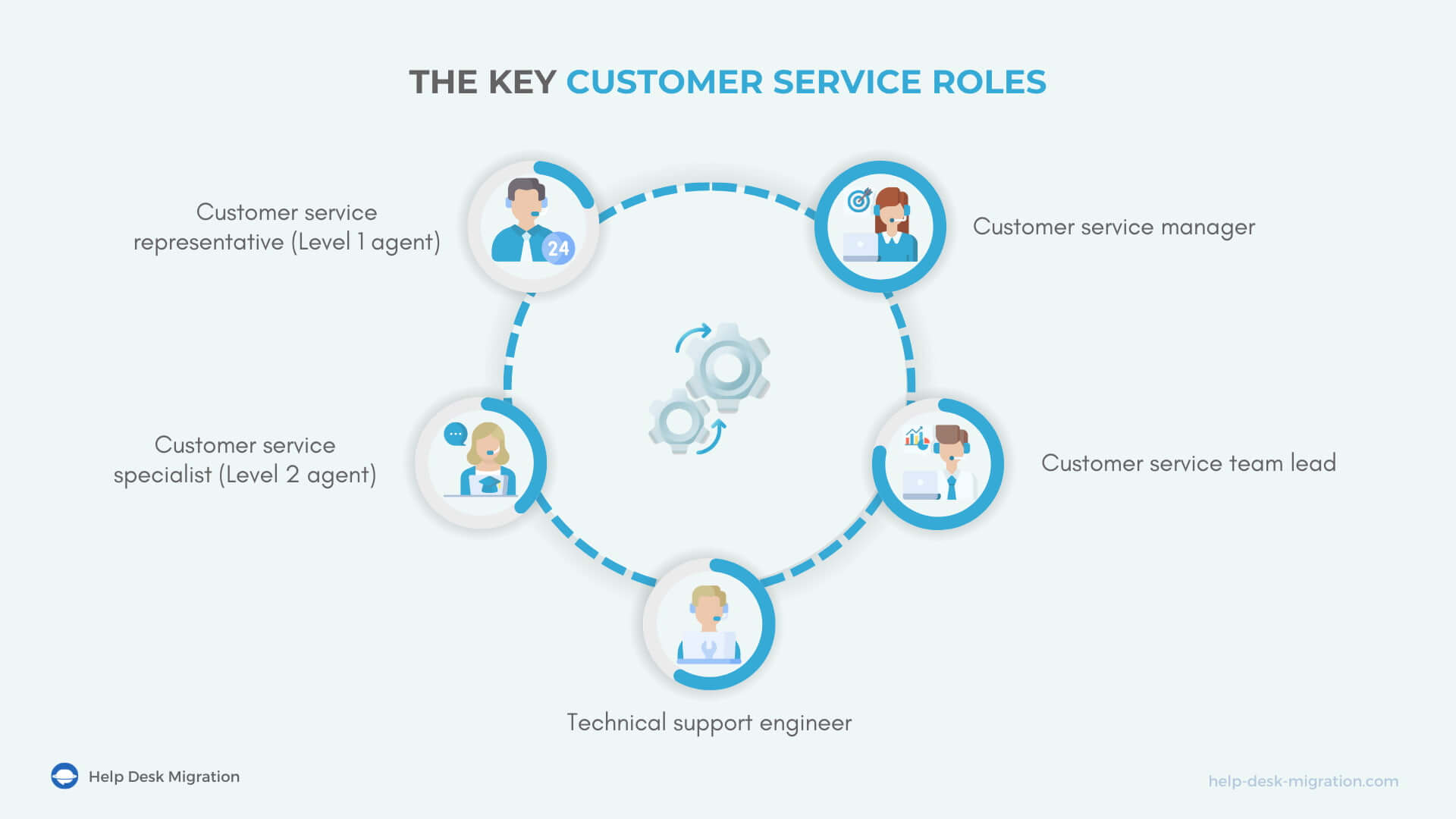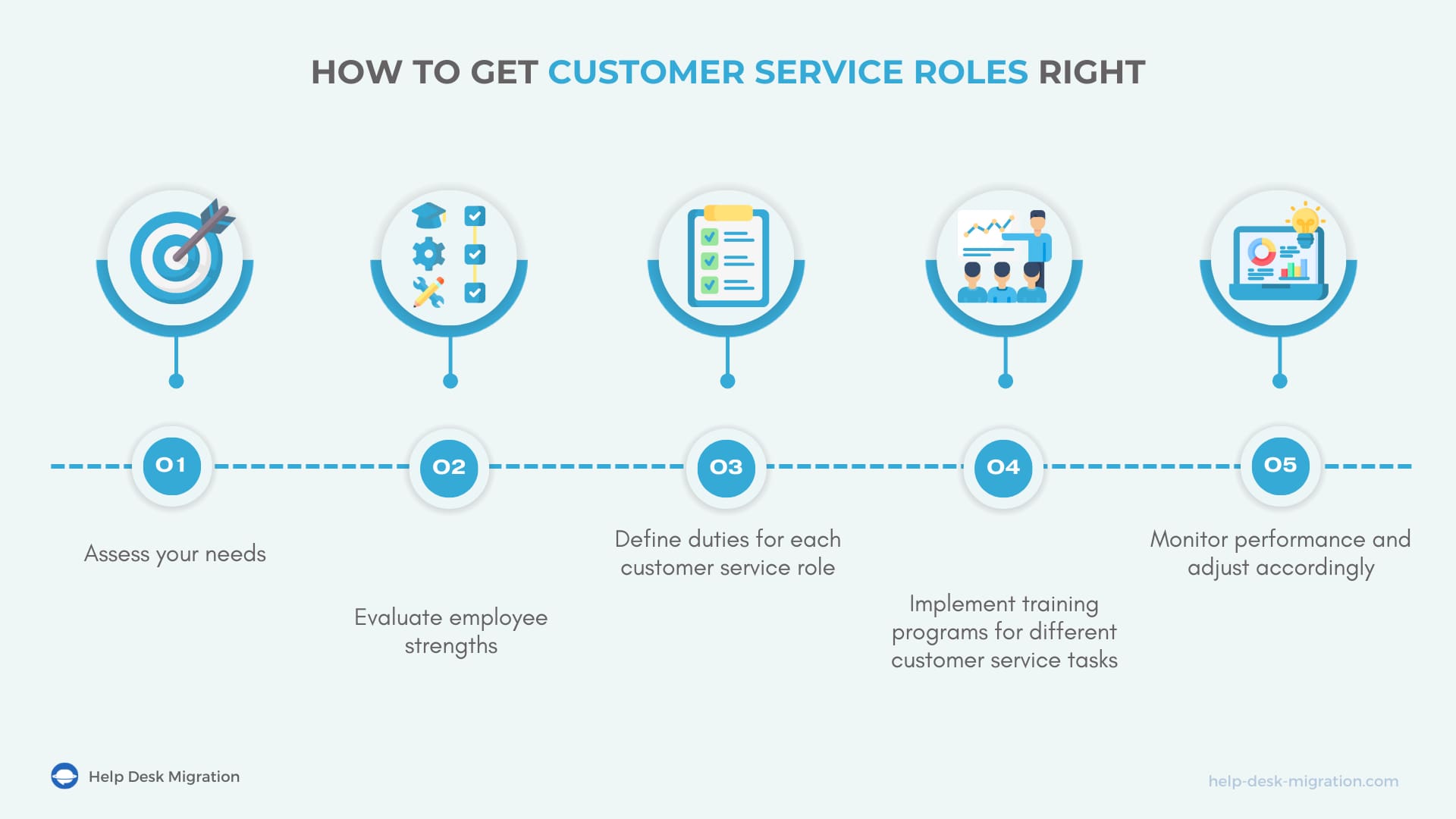Customer service roles and responsibilities are the cornerstone of any effective support team. It provides a clear framework that empowers every member—from frontline agents to technical specialists and managers—to excel in their duties. As a result, well-defined customer service roles boost operational efficiency, build trust, and foster stronger customer relationships.
Customer support is often called the heartbeat of a business, and for good reason. It plays a vital role in shaping customer experiences, building loyalty, and ultimately affecting the bottom line. According to Zendesk, 60% of customers have chosen one brand over another based on the quality of service they anticipate they will receive.
Even with advances in AI and automation, customer support still relies heavily on people. In fact, a recent study found that 64% of respondents prefer businesses not to rely on AI for customer service. Besides, there are many customer service tasks that only humans can perform effectively. For the time being, only humans can properly handle emotional situations, address complex inquiries, mentor new team members and manage other supervisory customer service responsibilities, and beyond.
In short, humans are still irreplaceable in customer support. To do their jobs well, they need to focus on what they excel at and understand their roles in customer service teams clearly.
The Key Customer Service Responsibilities and Roles
Addressing customer support inquiries is about more than just answering phone calls or emails; it involves a variety of tasks for the team to operate effectively.
First, it’s important to recognize that inquiries can vary widely. Some are straightforward, while others are more complex and require in-depth product knowledge. Second, all the jobs need to be allocated properly, and it’s essential to monitor how well the team is meeting its key performance indicators (KPIs) and whether all standards are met. And finally, both KPIs and standards don’t just appear out of the blue.
Someone needs to perform these and other customer service tasks. That’s why effective support teams involve diverse expertise.
Here are the key customer service roles.

Customer service representative (Level 1 agent)
A customer service representative (often called a Level 1 agent) is typically the friendly face (or voice!) that customers first contact for help via phone, email, chat, and other channels. So, what does a customer service representative do?
As the entry-level role in a customer support team, Level 1 agents handle basic customer inquiries. This can include tasks like processing orders, managing cancellations, and handling returns. These agents also assist with simple troubleshooting and guide customers through common issues. They play an important role in documenting interactions and sharing customer feedback with the team.
When a question goes beyond their expertise—such as inquiries that require deeper product knowledge—the main duty of the customer service representative is to pass the request along to a Level 2 agent, the next tier of support.
Customer service specialist (Level 2 agent)
This type of employee shares a lot of customer service duties with Level 1 agents. However, because they have more experience and in-depth product knowledge, they’re equipped to tackle more complex or sensitive issues that have been escalated from the first tier. In fact, many Level 1 agents are promoted to this role as they gain experience and expertise.
Level 2 agents dive deep into the root causes of customer problems, collaborating closely with Tier 1 agents to gather context on escalated cases.
Let’s say a customer reaches out to the support team because they’ve noticed an unexpected charge on their recent bill.
- The Level 1 agent checks the order history. They confirm that the order was processed correctly but can’t pinpoint the cause of the billing discrepancy. So, they escalate the issue to a Level 2 agent.
- The Level 2 agent reviews the customer’s billing history. They discover that a promotion was applied incorrectly during the last billing cycle. The agent explains this situation to the customer and suggests issuing a refund for the incorrect charge.
- The Level 2 agent processes the refund, ensuring that the customer’s account reflects the correct promotional pricing.
In addition to resolving issues, Level 2 agents often play a key role in training Tier 1 agents.
Technical support engineer
A technical support engineer is a customer service function that focuses on resolving technical issues (that are typically escalated from Level 1 and Level 2 agents). Going back to the example with the billing issue: if server-side issues are the cause for the error, the Level 2 agent will forward that request to the technical support engineer.
In addition to customer service duties, technical support engineers take a proactive approach to prevent problems by monitoring systems. They also collaborate with product development teams to address recurring technical challenges and create valuable documentation, such as user guides and troubleshooting resources, based on common customer issues.
Customer service team lead
A customer service team lead is a supervisory role within a support team.
While they might handle escalated issues from time to time, the key responsibility of a team lead is to manage agents. This typically involves monitoring team performance to help achieve KPIs and ensuring the right agent coverage to meet request volumes. They also play a crucial role in hiring, onboarding, and coaching customer support reps at all levels. Additionally, they develop and implement policies to keep service quality at a high level and act on customer feedback.
A customer service team lead typically reports to a customer service manager.
Customer service manager
The core duty of a customer service manager is overseeing the entire customer service department, which often includes multiple teams led by team leads. They monitor the performance of these teams, provide coaching and training opportunities (including for team leads), and develop service standards across the board.
While team leads act on an operational level, customer service managers focus on strategic decision-making. They set goals and objectives that align with the organization’s mission and work collaboratively with other departments to ensure a cohesive customer experience. Additionally, they manage the budget and resources for the department and generate reports for the upper management.
Having all these specialists on your team is great, but it’s not enough on its own. They also need to understand their own responsibilities as well as those of their teammates.
Why Customer Service Responsibilities Matter
Think of your support department as a house.
While having the right expertise in your support team is essential for success, it’s not enough on its own. Clear roles and responsibilities within the customer service department are just as critical. In construction terms, without this clarity all that expertise is like a pile of building materials instead of a well-structured house. This understanding brings everything together and gives purpose to each element.
When support staff are unclear about their roles and responsibilities, several issues can arise:
- Agents may not know how to address customer inquiries correctly, leading to long wait times. This can be frustrating for the 72% of customers looking for immediate service and lead to high call abandonment rates.
- Agents might struggle to figure out whom to contact for specific problems. Calls can get passed around from agent to agent, causing delays in resolution.
- Without a customer service manager or another supervisory role to facilitate communication with external teams, agents may find it challenging to resolve issues that go beyond their scope. For instance, if an agent encounters a pricing issue but can't access relevant information from the sales team, it can lead to delays and customer dissatisfaction.
- Customers may receive conflicting information from different agents. For example, one agent might offer a solution that another contradicts later due to misunderstandings about their roles or company policies.
Not only do customers suffer from this lack of clarity, but agents do as well. Without a clear hierarchy in customer service job titles and effective supervision, one agent might be overwhelmed with too many tasks while another sits idle. Alternatively, there could be too many agents without enough work, which creates inefficiency.
In short, getting customer service responsibilities right is crucial for everyone involved. Here’s how you can achieve that.
How to Get Customer Service Roles Right
Cards on the table: there isn’t a one-size-fits-all list of customer service roles and responsibilities. Each company has its own unique needs that shape the hierarchy of customer service job titles. So, the first step in building your customer service team is to assess those specific needs.
Now, let’s take a look at this and other essential steps for setting up the ideal support team.

Assess your needs
You don’t necessarily need to fill every possible customer service role. In fact, having too many agents or managers involved can sometimes create friction and lead to unnecessary expenses.
To avoid this, it’s important to assess your specific needs. Here are some key aspects to consider:
- Company size. In smaller organizations, it’s common to have a compact team where just a few individuals handle multiple roles. Larger businesses, however, often benefit from introducing more specialized positions to manage increased customer inquiries.
- Product complexity. If your company offers complex products or services, you may need more specialized support roles, like customer success managers and technical support engineers. On the other hand, businesses with simpler products might only need Level 1 agents for basic requests and Level 2 reps for more intricate inquiries.
- Volume of interactions. High volumes of customer inquiries typically require a larger support team with various tiers to ensure timely responses. Conversely, if you have a lower volume of inquiries, a smaller team can effectively manage all customer interactions.
Additionally, if your company has multiple product lines, having one team handle support for everything might be overwhelming. In such cases, it could be more effective to create separate teams for each product, each led by a team lead, with a manager overseeing all teams. The same approach applies if your business operates in multiple locations.
Evaluate employee strengths
Each customer service role requires a unique set of skills and qualifications. For instance, the duties of a customer service representative require strong communication skills, empathy, and a solid understanding of the products they support. On the other hand, supervisory positions like a team lead need excellent leadership skills and analytical thinking. Meanwhile, a technical support engineer must have a background in technology and knowledge of the systems the company uses.
Start your recruitment process internally: identify your employees’ skills, experiences, and preferences to further match them with customer service roles that align with their strengths. If you find any skill gaps within your organization, don’t hesitate to expand your recruitment efforts beyond your company to find the right talent.
Define duties for each customer service role
Restructuring your customer service department is only effective if you clearly define the responsibilities for each role. Since every business has its own unique needs, the list of duties for each customer service position will vary from one company to another.
To create your own customer service responsibilities lists, take a close look at your processes and assess your specific needs. Consider questions like: What types of requests will Level 1 agents typically handle? What issues should get escalated to Level 2 agents? Do all technical problems need to be directed to a technical support engineer? And who will be responsible for acting on customer feedback?
While answering these and other questions might feel a bit overwhelming, it’s essential for avoiding overlap and confusion down the line. Clear definitions will help everyone understand their roles and work together more effectively.
Implement training programs for different customer service tasks
In addition to clearly understanding their specific duties, all team members should be equipped to perform their tasks excellently. To achieve this, it's essential to provide training that is tailored to the unique tasks and challenges of each customer service function.
Training sessions can take many forms. Along with theoretical lessons, introduce practical exercises like simulating real-life customer interactions. This helps agents practice their responses and develop empathy. You can also analyze past customer interactions together with trainees to highlight best practices or allow them to shadow experienced agents to learn effective techniques firsthand.
Remember, training shouldn’t be a one-time event; it should evolve as your business grows and customer needs change. Regularly update your training materials based on new products, services, or customer feedback, and offer refresher courses or advanced training sessions to keep everyone’s skills sharp.
Monitor performance and adjust accordingly
Just like training isn’t a one-time event, the same goes for the structure of your customer service team. Your business is always evolving, and you can’t be certain that a new team structure will work perfectly right away—making adjustments is a natural part of the process.
To ensure everything runs smoothly, it’s important to regularly review performance metrics for each role to identify areas for improvement. Here’s a breakdown of some KPIs based on each role:
- Level 1 agent: average resolution time, first contact resolution (FCR), customer satisfaction score (CSAT), etc.
- Level 2 agent: escalation rate, technical resolution rate, etc.
- Team lead: team performance metrics such as average resolution time and FCR, training effectiveness based on metrics before and after training sessions, employee engagement scores, etc.
- Customer service manager: customer retention rates, net promoter score (NPS), overall resolution rates, and other departmental metrics.
- Technical engineer: average handling time, technical issue recurrence rates, etc.
Additionally, encourage feedback from team members about their roles and any challenges they face. This input can provide valuable insights that help refine your team structure and processes.
Conclusion
While customer support is the heartbeat of your business, the people behind it are its lifeblood. For that heartbeat to function smoothly, it’s essential to have the right individuals in the right roles. In other words, clearly defined roles and duties within your customer service team are crucial for optimal performance. We hope this article has provided you with valuable insights on how to organize your team effectively.
But one more important factor can significantly impact your customer support performance: a reliable help desk solution. If you discover you’re not using the right one, we’re here to help you make a smooth and secure transition with Help Desk Migration.



